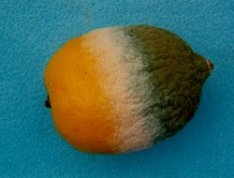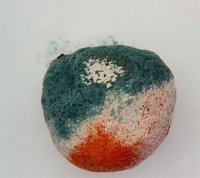- Types which absolutely have to have atmospheric oxygen to live (obligate aerobe)
- Types which thrive only in the absence of atmospheric oxygen (obligate anaerobe)
- Types which live in both the presence and absence of oxygen (facultative anaerobe)
Molds are generally typical aerobes, meaning that as a rule they colonize the surface of the goods (see Figs. 74 and 75). Controlled atmosphere storage, e.g. of apples, is an effective method of inhibiting aerobes. On the other hand, a large number of rot pathogens are anaerobes, capable of causing damage to preserved foods, for example.
 |
 |
| Figure 74: Lemon, suffering from green mold - stage III (white) and stage IV (green) | Figure 75: Blue mold caused by the fungal mold Penicillium italicum, stage III (white) and stage IV (blue), on an orange. Spores can be seen at the top. |